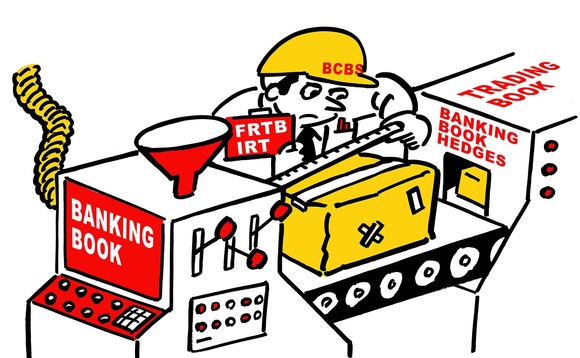
Could a phase-in save FRTB?
Regional banks fear they will run out of time to implement FRTB, but Europe’s proposal for a phase-in could set a welcome trend

For regulators wondering how regional banks are getting on with their efforts to implement the Basel Committee's Fundamental review of the trading book (FRTB), Risk.net's inaugural survey on the subject should be an eye-opener.
Asked for their views on key elements of the framework, 11 regional banks from around the world answered – and their responses made for uniformly grim reading. Top of the list of concerns was securing approval for trading desks to use the internal model approach (IMA) under the regime. More than half of those surveyed feared 20% or more of their desks were likely to lose IMA approval; two said 80% or even 100% of their desks would be in the firing line.
Losing approval would be a blow: desks that fail to qualify for the IMA will be forced on to the more punitive standardised approach, which could produce a capital jump of between 2 and 6.2 times.
The biggest barrier to a desk gaining approval to use IMA will be Basel's fiendishly complex P&L attribution test, used to determine whether a dealer's risk models track the desk's actual performance sufficiently closely – something they can no longer rely on backtesting alone to prove.
In some quarters at least, regulators seem alive to the problem. An analysis prepared by the European Banking Authority (EBA) for the European Commission suggested approximately 40% of desks would likely fail the P&L attribution test. This matters, since it will be up to the EBA to pen the technical standards that will underpin Europe's version of the rules once the EC's legislative proposal has been agreed on and transposed into European law next year. A sympathetic hearing for dealers here would be very useful indeed.
Front and centre in the EC's proposal when it emerged in late November was an acknowledgement that implementing FRTB is likely to lead to a "steep increase" in banks' own fund requirements for market risks – something European legislators fear could lead to the continent's capital markets seizing up if all aspects of the rules enter into force simultaneously. That has led the EC to call for a three-year phase-in for the framework.
A longer lead-in time would help the market: almost half of Risk.net's survey respondents said they would need at least three years to fully implement FRTB. In addition, a desk wishing to use the IMA must have been running P&L calculations for at least a year before applying the attribution test, further eroding the time available to get the ducks in line.
Regional lenders, for which the barriers to implementation look more difficult still – either the markets in which they operate are too illiquid to apply the P&L attribution test successfully, or they have too few quants to cope with a shift in modelling approaches – will be hoping local market regulators take a leaf out of the EC's approach. The longer Europe seeks to delay full implementation of the regime, though, the greater the risk of global regulators' approaches diverging.
Further reading
Only users who have a paid subscription or are part of a corporate subscription are able to print or copy content.
To access these options, along with all other subscription benefits, please contact info@risk.net or view our subscription options here: http://subscriptions.risk.net/subscribe
You are currently unable to print this content. Please contact info@risk.net to find out more.
You are currently unable to copy this content. Please contact info@risk.net to find out more.
Copyright Infopro Digital Limited. All rights reserved.
As outlined in our terms and conditions, https://www.infopro-digital.com/terms-and-conditions/subscriptions/ (point 2.4), printing is limited to a single copy.
If you would like to purchase additional rights please email info@risk.net
Copyright Infopro Digital Limited. All rights reserved.
You may share this content using our article tools. As outlined in our terms and conditions, https://www.infopro-digital.com/terms-and-conditions/subscriptions/ (clause 2.4), an Authorised User may only make one copy of the materials for their own personal use. You must also comply with the restrictions in clause 2.5.
If you would like to purchase additional rights please email info@risk.net
More on Risk management
Institutional priorities in multi-asset investing
Private markets, broader exposures and the race for integration
12 angry members: why dissent is growing on the FOMC
Hardening views on wisdom of further cuts mean committee’s next meeting is unlikely to be harmonious
LSEG streamlines post-trade efficiency across cleared and uncleared markets
LSEG’s Post Trade Solutions extends clearing-style efficiencies to bilateral markets, helping Apac clients navigate rising margin and risk management pressures
Squashing CVA still dominates XVA desks’ priorities
Dealers favour options-based strategies to manage charges; some explore contingent CDSs amid rising exposures
EU single portal faces battle to unify cyber incident reporting
Digital omnibus package accused of lacking ambition to truly streamline notification requirements
XVA desks prioritise core tech upgrades over AI
Vendor upgrades, cloud-native rebuilds and sensitivities tooling dominate 2026 budget road maps
Chicago data centre outage forced clearers to turn away clients
Friday’s cooling system failure highlights cracks in tech and concentration risk of big CCPs
LCH goes live with agency model for client clearing
English law version of FCM-style European trust model approved, as Eurex lags behind








